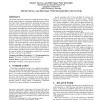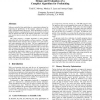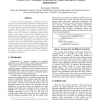ISCA
2011
IEEE
13 years 5 months ago
2011
IEEE
Chip multiprocessors (CMPs) share a large portion of the memory subsystem among multiple cores. Recent proposals have addressed high-performance and fair management of these share...
ICS
2000
Tsinghua U.
14 years 5 months ago
2000
Tsinghua U.
Memory system bottlenecks limit performance for many applications, and computations with strided access patterns are among the hardest hit. The streams used in such applications h...
CODES
2004
IEEE
14 years 5 months ago
2004
IEEE
The memory subsystem accounts for a significant portion of the aggregate energy budget of contemporary embedded systems. Moreover, there exists a large potential for optimizing th...
POPL
1994
ACM
14 years 5 months ago
1994
ACM
Heap allocation with copying garbage collection is believed to have poormemory subsystem performance. We conducted a studyofthememory subsystem performance of heap allocation for ...
ASPLOS
1992
ACM
14 years 6 months ago
1992
ACM
Software-controlled data prefetching is a promising technique for improving the performance of the memory subsystem to match today's high-performance processors. While prefet...
DATE
2002
IEEE
14 years 6 months ago
2002
IEEE
In programmable embedded systems, the memory subsystem represents a major cost, performance and power bottleneck. To optimize the system for such different goals, the designer wou...
HPCC
2005
Springer
14 years 7 months ago
2005
Springer
In this paper we present an exhaustive evaluation of the memory subsystem in a chip-multiprocessor (CMP) architecture composed of 16 cores. The characterization is performed making...
DATE
2005
IEEE
14 years 7 months ago
2005
IEEE
In today’s embedded applications a significant portion of energy is spent in the memory subsystem. Several approaches have been proposed to minimize this energy, including the u...
IESS
2007
Springer
14 years 8 months ago
2007
Springer
NoCs present a possible communication infrastructure solution to deal with increased design complexity and shrinking time-to-market. The communication infrastructure is a signific...
GLVLSI
2008
IEEE
14 years 8 months ago
2008
IEEE
Due to the large contribution of the memory subsystem to total system power, the memory subsystem is highly amenable to customization for reduced power/energy and/or improved perf...






